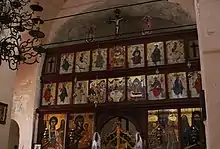Krupa monastery
The Krupa Monastery (Serbian: Манастир Крупа, romanized: Manastir Krupa) is a Serbian Orthodox monastery on the Krupa River in Croatia.[1] It is one of the oldest Orthodox monasteries in Croatia, alongside Krka and Dragović monasteries.
 | |
| Monastery information | |
|---|---|
| Full name | Manastir Krupa, Манастир Крупа |
| Order | Serbian Orthodox Church |
| Established | c. 1642 |
| Dedicated to | Feast of the Dormition of Theotokos |
| Site | |
| Location | |
| Public access | Yes |
Location
It is located on the southern slopes of the Velebit mountain,[2] halfway between the towns of Obrovac and Knin.
History
According to the folk tradition, the monastery was built in 1317 by monks from Bosnia with the financial support from the Serbian king Milutin, later renovated by King Stefan Dečanski and Emperor Dušan, and in the 15th and 16th centuries endowed by Saint Angelina of Serbia.[1] However, as the monastery has Gothic-style windows which was uncommon for the Orthodox Church, it was suggested the monastery was probably built by immigrating monks only around 1642.[3]
Cretan priest Ioannis Apakas painted four "throne icons" for the iconostasis in c.1600.[4][5] Georgije Mitrofanović painted the walls in 1620–22. In the 1760s, Serbian writer and educator, Dositej Obradović, lived and worked in Krupa, while in the 1860s, major Serbian realist author, Simo Matavulj, lived and was educated in the monastery. Gerasim Zelić also lived there in the 18th century. It was completely renovated in 1855.[1][2]
The surrounding konaks were burnt to the ground by the Ustaše during the World War II, who also destroyed the interior of the monastery turning it into their military post. In the 1950s the construction of the large belfry began but was never finished. After the outbreak of the Croatian War of Independence in 1991, the well-known monastery treasury was displaced from Krupa. During the Operation Storm the monastery sustained damages and the local Orthodox Serbs, so as the priests, went into exile in Serbia. The belfry and the bells were damaged, so as the chapel, while the interior was looted and partially demolished. Since 2000, partial reconstruction of Krupa began. It included numerous works, such as the construction and painting of the small additional church (paraklis) and the partial adaptation of the unfinished belfry. Some of the artifacts were returned in 2010. Since the mid-2010s, the government of the Republic of Croatia also helped with the renovation of the monastery.[1][2]
History of the monastery was written in the 18th century chronicles of the Bishop of Dalmatia, Simeon Končarević.[2]

Characteristics
The church of the Krupa monastery is dedicated to the Feast of the Dormition of Theotokos. In the monastery there are beautiful frescoes, a valuable collection of icons and parts of iconostasis and the collection of the several centuries old books.[2]
See also
References
- "Monastery Krupa". Eparchy of Dalmatia. 2004.
- Gvozden Otašević (4 July 2017), "Svetinja sa sedam života", Politika (in Serbian), p. 20
- "Krka & Krupa". Enciklopedija likovnih umjetnosti (Encyclopedia of Fine Arts) (in Serbo-Croatian). Vol. 3. Zagreb: FNRJ. 1964. p. 256.
Krupa, srpsko-pravoslavni manastir u dalm. Bukovici, Hrvatska. Osnovali su ga, vjerojatno, bos. kaluđeri koji su bježali pred Turcima (1642). Na manastirskim zgradama sačuvani su gotički prozori; crkva je jednobrodna građevina s kubetom. U crkvi se ističu bogato rezbarene carske dveri, zbirka ikona iz XVII i iz XVIII st. (većinom djela italo-keltske škole), te srebrni predmeti iz XVIII st. venec. podrijetla. Bogata biblioteka stradala je u Drugom svjetskom ratu.
- "Kulturno blago manastira Krupa vraćeno iz Srbije" [Cultural treasure from Krupa monastery returned from Serbia]. Zadarski list (in Croatian). 5 November 2011.
- Petra Jurlina, ed. (2013). Bukovica & Ravni kotari / cultural heritage guide. Zagreb: University of Zagreb. p. 206. ISBN 978-953-6002-71-9.
Further reading
- Ćirković, Sima (2004). The Serbs. Malden: Blackwell Publishing.
- Mileusnić, Slobodan (1997). Spiritual Genocide: A survey of destroyed, damaged and desecrated churches, monasteries and other church buildings during the war 1991-1995 (1997). Belgrade: Museum of the Serbian Orthodox Church.
- Miller, Nicholas J. (1997). Between Nation and State: Serbian Politics in Croatia Before the First World War. Pittsburgh: University of Pittsburgh Press.
- Вуковић, Сава (1996). Српски јерарси од деветог до двадесетог века (Serbian Hierarchs from the 9th to the 20th Century). Евро, Унирекс, Каленић.

